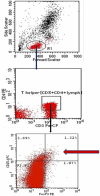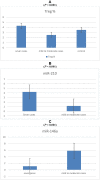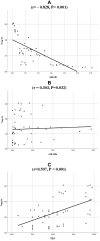MicroRNA-146a-5p and microRNA-210-3p Correlate with T Regulatory Cells Frequency and Predict Asthma Severity in Egyptian Pediatric Population
- PMID: 36714048
- PMCID: PMC9880026
- DOI: 10.2147/JAA.S398494
MicroRNA-146a-5p and microRNA-210-3p Correlate with T Regulatory Cells Frequency and Predict Asthma Severity in Egyptian Pediatric Population
Abstract
Background: Severe bronchial asthma (BA) affects 5-10% of children, which imposes socioeconomic burden. Therefore, it is crucial to identify biomarkers for risk stratification in children with BA. T regulatory cells (Tregs) play a balancing role in allergic response regulation. We aimed to investigate the relationship between Treg, miR-210-3p, and miR-146a-5p in relation to asthma phenotypes in search of novel biomarkers of disease severity.
Methods: This study included 50 children with BA classified into Group 1 (n = 25) children with mild to moderate asthma and Group 2 (n = 25) children with severe asthma. In addition to 26 control subjects. Flow cytometry was used to detect Tregs. Plasma miR-210-3p and miR-146a levels were determined using quantitative real-time PCR. Patients' FEV1 (Forced Expiratory Volume in the first second) was measured.
Results: miR-210-3p level correlated negatively with Treg frequency (r = -0.828, P < 0.001) and FEV1 (r = -0.621, P < 0.001). The level of miR-146a-5p positively correlated positively with Treg% (r = 0.303, P = 0.032). ROC curve analysis revealed that miR-210-3p was the most sensitive biomarker of severity, with the area under curve (AUC) = 0.923, 96% sensitivity, and 60% specificity. According to multivariate analysis, miR-210-3p is an independent risk factor for BA severity [OR =3.119, P = 0.030], while miR-146a-5p is a protective factor [OR =0.811, P = 0.049].
Conclusion: Treg frequency is linked to FEV1, miR-146a-5p and miR-210-3p in childhood BA. Upregulation of miR-210-3p is a sensitive biomarker and an independent risk factor for BA severity in Egyptian children.
Keywords: T reg; asthma classifications; childhood asthma; miR-146a-5p; miR-210-3p.
© 2023 Eldosoky et al.
Conflict of interest statement
The authors report no conflicts of interest in this work.
Figures



Similar articles
-
Circulating miR-146a-5p and miR-132-3p as potential diagnostic biomarkers in epilepsy.Epilepsy Res. 2023 Mar;191:107089. doi: 10.1016/j.eplepsyres.2023.107089. Epub 2023 Feb 9. Epilepsy Res. 2023. PMID: 36801489
-
The Plasma Levels of hsa-miR-19b-3p, hsa-miR-125b-5p, and hsamiR- 320c in Patients with Asthma, COPD and Asthma-COPD Overlap Syndrome (ACOS).Microrna. 2021;10(2):130-138. doi: 10.2174/2211536610666210609142859. Microrna. 2021. PMID: 34151771
-
Plasma Levels of MicroRNA-146a-5p, MicroRNA-24-3p, and MicroRNA-125a-5p as Potential Diagnostic Biomarkers for Rheumatoid Arthris.Iran J Allergy Asthma Immunol. 2021 Jun 6;20(3):326-337. doi: 10.18502/ijaai.v20i3.6334. Iran J Allergy Asthma Immunol. 2021. PMID: 34134454
-
Aberrant expression of microRNA-132-3p and microRNA-146a-5p in Parkinson's disease patients.Open Life Sci. 2020 Sep 2;15(1):647-653. doi: 10.1515/biol-2020-0060. eCollection 2020. Open Life Sci. 2020. PMID: 33817253 Free PMC article.
-
MicroRNAs and the Diagnosis of Childhood Acute Lymphoblastic Leukemia: Systematic Review, Meta-Analysis and Re-Analysis with Novel Small RNA-Seq Tools.Cancers (Basel). 2022 Aug 17;14(16):3976. doi: 10.3390/cancers14163976. Cancers (Basel). 2022. PMID: 36010971 Free PMC article. Review.
Cited by
-
The Roles of MicroRNAs in Asthma and Emerging Insights into the Effects of Vitamin D3 Supplementation.Nutrients. 2024 Jan 24;16(3):341. doi: 10.3390/nu16030341. Nutrients. 2024. PMID: 38337625 Free PMC article. Review.
References
LinkOut - more resources
Full Text Sources

